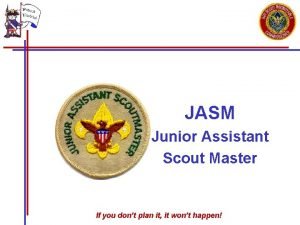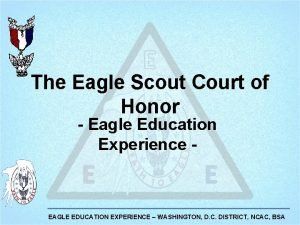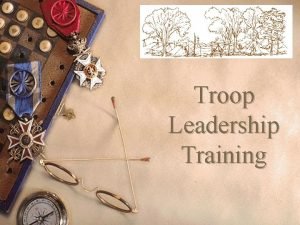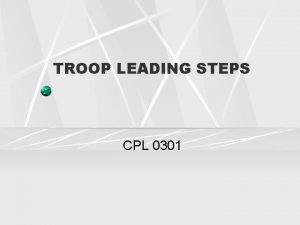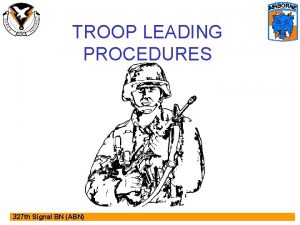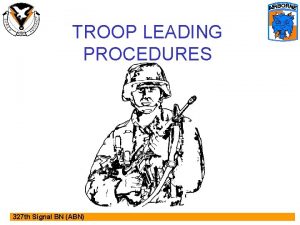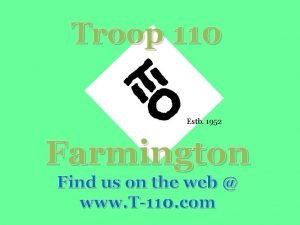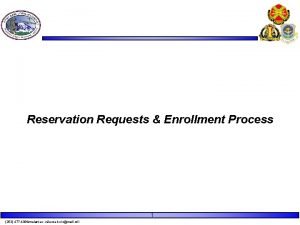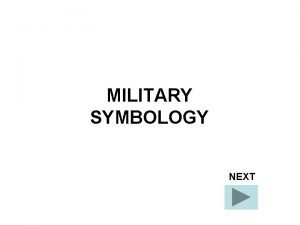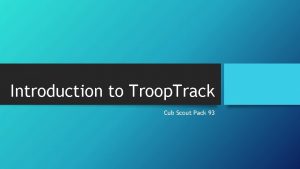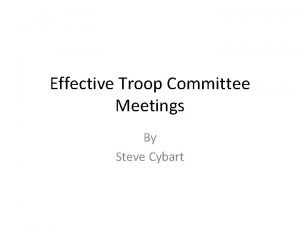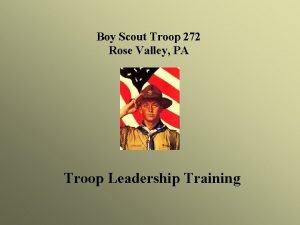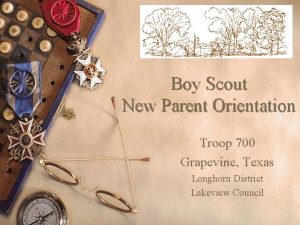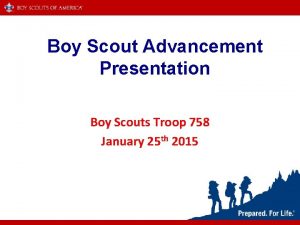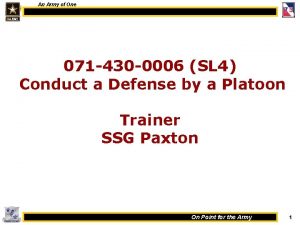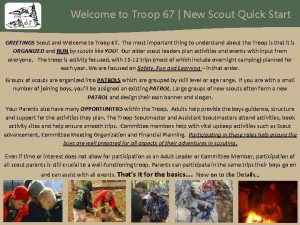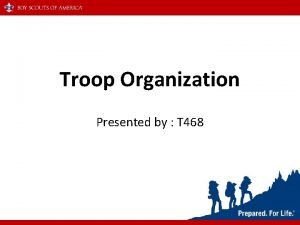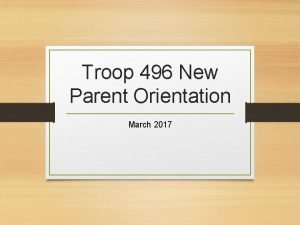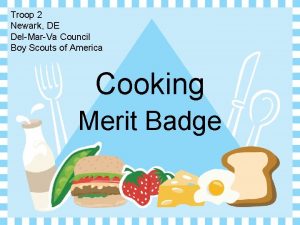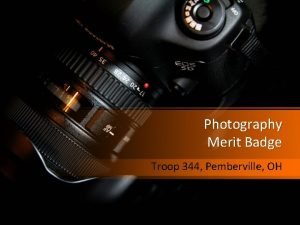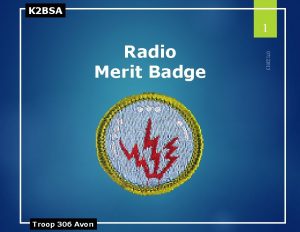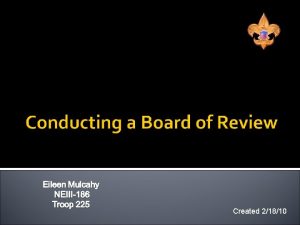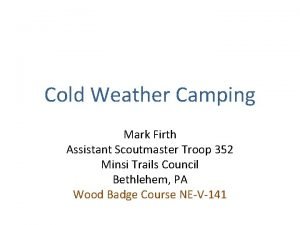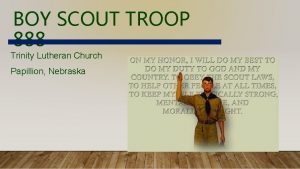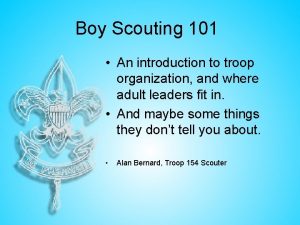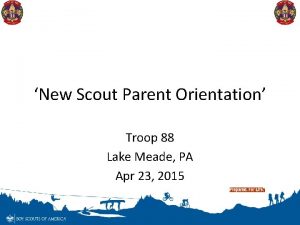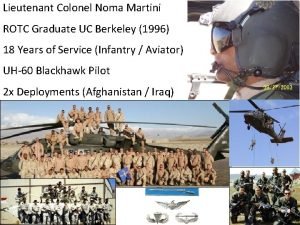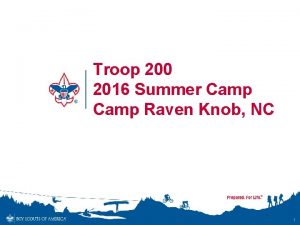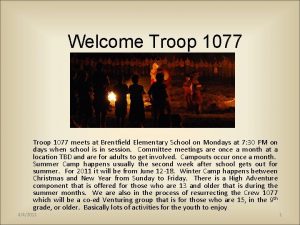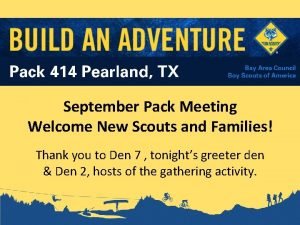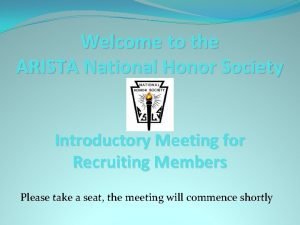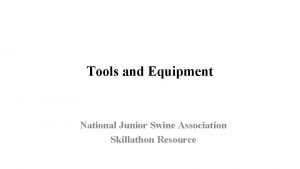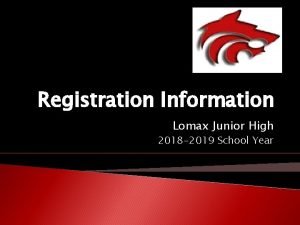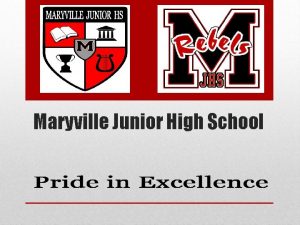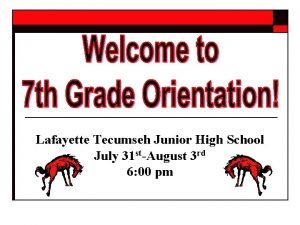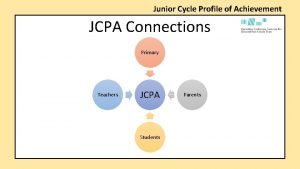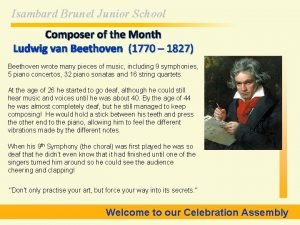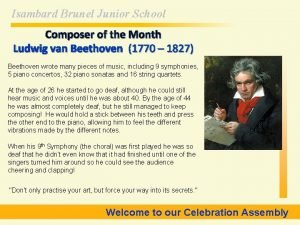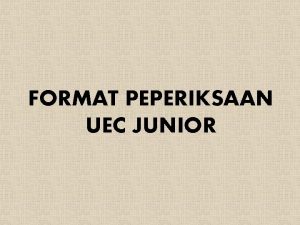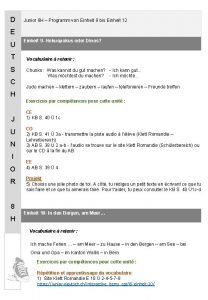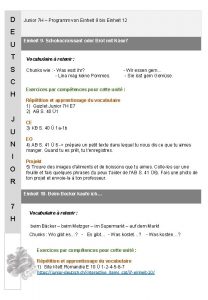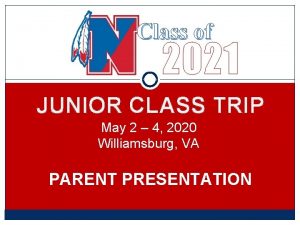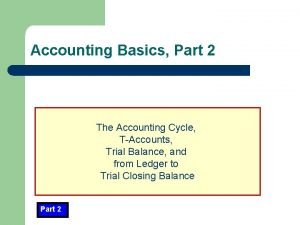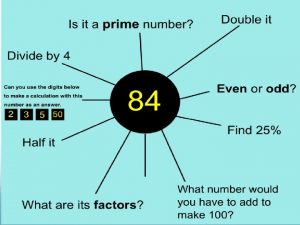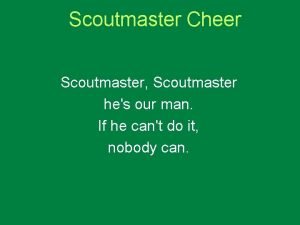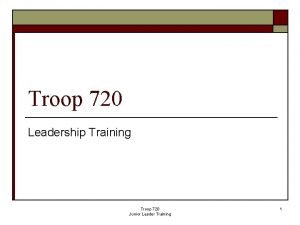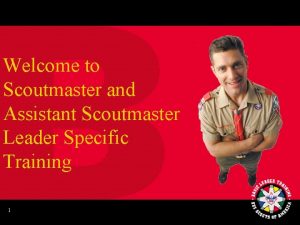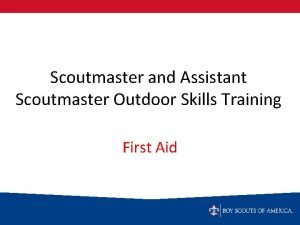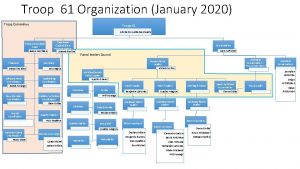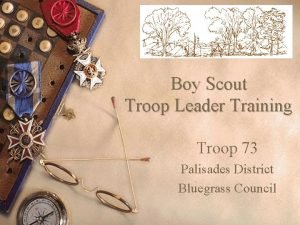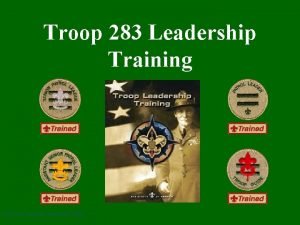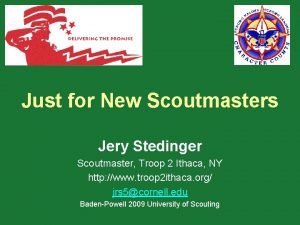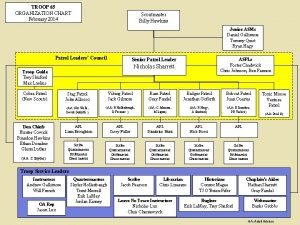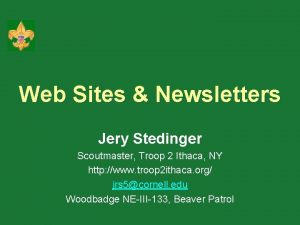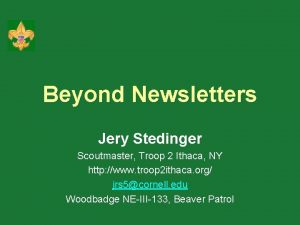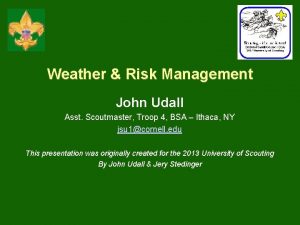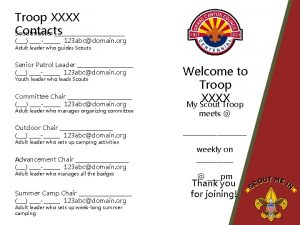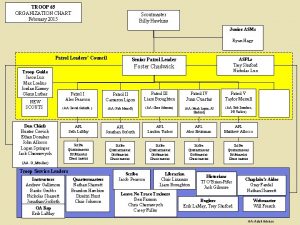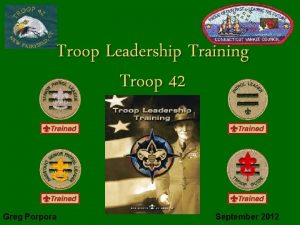Troop xx Junior Leader Training name Scoutmaster name

























































































- Slides: 89

Troop xx Junior Leader Training <name>, Scoutmaster <name>, Senior Patrol Leader <location> <date>

Introduction Purpose: To give YOU the resources YOU need to do YOUR job Evidence: Upon completion, YOU will wear the “Trained” emblem Method: games, videos, hand outs, demonstrations, plus The Junior Leader Handbook, and other resources

Query How many have had this course before? How many have been through a Council-level course, Bristlecone?

Agenda We will cover: – Leadership – Cooperation – Have a meal break – Problem Solving – Team Building Presentation Certificates of Patches and

Warm-Up Game #1 The Monster – Form a “Monster” that must travel 15 - 20 feet – No more than 1/2 the legs and 1/2 the arms, plus one of either, may touch the ground – All group members must be connected to form the monster

“The Monster” Reflection What was the purpose of this activity? What were the group’s strengths and weaknesses? How did this process work for the group? What kinds of problems did the group have? How did the group deal with its problems? What have you learned from this activity?

Warm-Up Game #2 Yurt Circle – Join hands and expand the circle outward until the circle is tight – Count off by twos – Bending at the ankles, not the waist, ones lean in and twos lean out – Do it slowly, then reverse positions – (Start now) – If everyone works together, each person can accomplish a remarkable forward or backward lean

Warm-Up Game #3 Everybody Up – Let’s try to build group cooperation – Two same-size persons sit down facing each other, legs out, knees bent, feet touching opposite person’s feet – Grasp other persons hands tightly, and pull each other into upright standing position – Repeat, adding more and more people on each side, until everyone is included – (Start now)

Reflection on Everybody Up Were you eventually able to get everybody included, and upright? Is there any real limit to the number of people that can play this game, as long as they work together? Would Yurt Circle, and Everybody Up be fun games for the Troop?

Why are we here today? To learn a leadership skills that work great in Scouting To learn to work together to accomplish a common goal To learn how to deal with problems we all encounter in Scouting And to have some fun at the same time

Overview “I’m a leader - what do I do now? ” Being a leader is more than an honor, it’s a challenge You lead Troop 92 and your Patrol You decide the course the Patrol and Troop will follow along the Scouting trail You help others master Scouting skills You are a role model for other Scouts.

What Is Leading Anyway? If others think of you as the boss, you’re probably not leading. If they think of you as one of the guys and everything you set out to do is getting done, you’re probably a good leader.

Skills and Techniques of Successful Scout Leaders: They ask a lot of questions They make a lot of suggestions They don’t give too many orders They use the Scoutmaster and Assistant Scoutmasters as resources. They took Troop Junior Leader Training – That’s why you are here today!

Further Training Opportunities: Council-level Junior Leader Training -<name of council level training> – <name of training -- A week-long training conference in <date> at <location> – The Troop will pay for Scouts to attend National Junior Leader Instructor Camp – Philmont Scout Ranch in New Mexico

Get Into Your Job Break It Down into Pieces Tackle one piece at a time Think of your Junior Leader Handbook as a toolbox. – take it with you to meetings – take it on campouts – take it to summer camp

Presentation of Junior Leader Handbooks Put your name in it now Read it, know it, follow it Keep it as a resource for the rest of your Scout career Let’s look into the Junior Leader Handbook

Other “toolboxes”: Boy Scout Handbook – The basic tool for all Scouting Woods Wisdom - a good source for: – Games (for learning and for fun) – Ceremonies (how about some new ones? ) – Program monthly themes The Troop’s adult leaders Other junior leaders

Now let’s watch a video segment on leadership (Start the first video segment now)

Let’s Try Activity #1 Kim’s Game -- The JLT Way (The JLT way is with at least 100 items. Items are shown for 1 minute, Scouts keep silent. All scouts do it individually, with the Scoutmaster acting as the “big boss”. Then they do it a second time, they all look at the items for 1 minute in silence, then the Scoutmaster gives one instruction -- “I want one list”. The object is to see how they solve the problem, who steps up to leadership, etc. Delete this text before you show these viewgraphs. )

Reflection on the “Kim’s Game” Who took the leadership role? How did decisions get made? What didn’t you like about this style? How often do leaders act like “big bosses”? How does it feel to be lead by “big boss”? Is “big boss” style prevalent in Scouting? Could we play this without “Big Boss”?

Reflection on “Kim’s Game” Who took the leadership role the second time? How did decisions get made? Why did we do this activity two different ways

Identifying the Traits of a Good Leader: 1. 2. 3. 4. 5. 6. 7.

Now let’s watch the next video segment, “Cooperation” (resume video)

Some comments on the video Tommy’s question led to a better job of packing No put-downs, or “I’ll take charge”, just a focus on the problem Teenagers get bossed around enough Scouting ought to be different The alternative to the “big boss” style is shared leadership, helping others to set goals and assist in reaching them

Standing Tall, Up Front The Job of the SPL: The master of ceremonies – makes sure things happen as planned Looks ahead to “next time” – did the original plan really work out well? – what should we do differently next time? – should hold a critique after each activity Looks at your friend, the Scoutmaster, as a resource

Helping Others Grow When someone doesn’t do the assigned task, it is the SPL’s job to find someone who will Resist the urge to pick up a dropped ball and run with it – Rather, pick it up and pass it to someone else – This is called DELEGATING » Delegating is one trait of a good leader » It allows others to grow in experience

The SPL has lots of helpers to call upon: The Assistant Senior Patrol Leader – that’s what assistants are for The Leadership Corps – Scribe, Quartermaster, etc. Other junior leaders

The Senior Patrol Leader Is elected by the Scouts to represent them as the top junior leader in the troop The SPL reports to the Scoutmaster

Senior Patrol Leader Duties: Runs all troop meetings, events, activities, & the annual program planning conference Runs Patrol Leaders’ Council meetings Appoints other Troop junior leaders – with advice and counsel of Scoutmaster Assigns duties and responsibilities to junior leaders Assists with Junior Leader Training

And as with all other Junior Leaders Sets a good example Enthusiastically wears the Scout uniform correctly Lives by the Scout Oath and Law Shows Scout spirit

The Assistant Senior Patrol Leader 2 nd highest junior leader in the troop Appointed by the SPL Acts as SPL when SPL is absent Provides leadership to other junior leaders

Assistant Senior Patrol Leader Duties: Helps SPL lead meetings and activities Runs troop in absence of SPL Helps train and supervise troop Scribe, Quartermaster, Instructors, Librarian, Historian, and Chaplain Aide Serves as a member of the Patrol Leaders’ Council Sets a good example in the uniform, Oath, Law, & spirit

The Patrol Leader The elected leader of his patrol Represents his patrol on the Patrol Leaders’ Council Reports to the SPL

The Patrol Leader’s Duties Appoints assistant patrol leader Represents patrol on the PLC Plans and steers patrol meetings Helps Scouts advance Chief recruiter for new scouts Keeps patrol members informed Knows his resources – his other patrol members & other leaders Sets example - uniform, Oath, Law, & spirit

The Assistant Patrol Leader Is appointed by the patrol leader and Leads the patrol in the PL’s absence

Assistant Patrol Leader duties: Helps PL plan and steer patrol meetings and activities Helps PL keep patrol members informed Helps patrol get ready for all troop activities Represents his patrol at the PLC when PL can not attend Helps control the patrol and helps build patrol spirit Sets example - uniform, Oath, Law, & spirit

Patrol organization: Patrol scribe - keeps patrol log, attendance records, dues, budgets for patrol activities Patrol grubmaster - menu planner, food shopper, sees the patrol “eats right” Patrol quartermaster - keeps patrol gear in order Patrol cheermaster - leads songs, yells, stunts, and campfire programs Patrol chief cook - organizes cooking meals

Patrol Organization = Sharing Leadership The patrol jobs can be for months or only weeks at a time Rotate assignments - plenty of jobs to go around Sharing gives each Scout a chance to “buy in” If each has a part in a plan’s creation, each will do his best to make it come out right

Troop Leadership Corp Jobs: Every troop needs a Leadership Corps to get the job done “Behind the scenes” but still very important Set good example for all scouts All of the following staffers report to the Assistant Senior Patrol Leader

Troop Scribe Attends and keeps the official record of the Patrol Leaders’ Council Records individual Scout attendance and dues Records individual Scout advancement Records who goes on outings Example - uniform - Oath - Law - spirit

Troop Quartermaster Keeps records of patrol and troop equipment Ensures equipment is in good working order Issues equipment and ensures it is returned in good condition Suggests new or replacement items Example - uniform - Oath - Law - spirit

Troop Instructors Teach basic Scouting skills to troop and patrols Can prepare and make special presentations that will be educational for troop meetings – games with a point, from Woods Wisdom, etc. – learning can be fun, if you make it so Example - uniform - Oath - Law - spirit

Chaplain Aide Assists troop chaplain with religious services at troop activities Tells Scouts about religious emblem program Ensures religious holidays considered in troop program planning Plans religious observances at troop outings Example - uniform - Oath - Law - spirit

Troop Librarian Sets up and cares for troop library – records new troop books and pamphlets – runs troop lending library and follows up on late returns Example - uniform - Oath - Law - spirit

Troop Historian Gathers pictures and facts about past troop activities Keeps troop historical file and/or scrapbook Cares for troop trophies, ribbons, souvenirs Keeps information about former troop members Example - uniform - Oath - Law - spirit

Our Troop is just one part in the National Scouting movement

The Council is Basic Scouting Above the Troop Level

Troop 92’s Organization Chart

The Patrol Leaders Council Purpose – Plan the meetings – Plan other activities – Communicate up from the patrol members – Communicate down to the patrol members SPL leads the PLC SPL plans the meetings, passes the plan to the other leaders

Our Model PLC Set up a table, with chairs for the SPL, PL’s and APL’s. Everyone else gather behind them SPL lead the PLC to plan the meetings for January

Activity #3 - My Tree Pair off, one person blindfolded. Sighted Scout leads the other in a roundabout path to a tree. Blind Scout examines tree using touch, smell Sighted Scout leads blind Scout back to starting position Blind Scout takes off blindfold, then must find his tree. Trade places and do it again.

Reflection on “My Tree” What did you like about this activity? What skills were developed in this activity? How did you find your tree? Did you trust your partner? Why or why not? Did you want the other person to succeed or not? Why? How is having a disability for only a short time different from having to deal with a situation for a lifetime?

Are differences good or bad? How are we different from one another? How do differences strengthen the group as a whole? When do differences keep a group from reaching its goal? How can we find out about the special qualities and abilities of each member of our troop? Are these talents differences?

I’m hungry - how about you? Pick up a food sack and let’s eat!

Reflection on the meal activity When you first opened you bag, did you consider not sharing? Why? What happened? How did the group work together to prepare lunch? What happened? Were all ideas given fair consideration? How did you feel if your idea was rejected? How difficult was it to reach a decision all could agree on?

A Leader’s comment Our success as leaders will be determined by how well we are able to take the unique talents of each member of our group and mold them into a team committed to accomplishing a common goal

What are our Common Goals? 1. 2. 3. 4. 5. 6. 7.

Here are Some of our Common Goals 1. Treat everyone fairly -- share the responsibilities, share the effort 2. Each Patrol works as a Team 3. Each Patrol has an identity -- flag, yell, their own equipment, etc 3. Everyone feels that they belong -no put-downs, harassing, etc. 4. Everyone is safe

Problem Solving (first part) This segment deals with problem solving - there are three sequential steps a boy can take to frame a problem and see it in a larger context. . .

Steps to frame a problem: Empathy - put yourself in the other’s place Invention - invent as many solutions as you can Selection - which is best for the most people - caring is as important as justice Now here’s the video. . . (start video, proceed afterwards)

Activity #5 - the “Tent Scene” Divide into groups of about three people Discuss how your group would resolve the conflict over the tent flaps Each group will then present their solution in the form of a skit or role-playing After all skits completed, we’ll return to the video to see how Tommy solved the problem (Let’s do it now)

Activity #6 - “Magic Numbers” The purpose of this activity is to show scouts may need to look at several possible alternatives before arriving at a no-lose situation The leader will use items such as pencils or sticks to make an interesting pattern on the ground. The object is to guess the number represented.

Reflection on “Magic Numbers” How did you feel during the game? Why? How did you feel as other members of the group figured out the problem? What made this activity difficult? Why? How did the leadership role shift as the game progressed? How did someone else manage to gain the leadership role? What have you learned during this activity that can help you fulfill your position in the troop more effectively? (Go to the video)

Activity #7 - The “Scene” with Tommy and Sam Divide yourselves into two groups Use empathy, invention, and selection to deal with the Sam and Tommy problem Each group is to select two actors to portray their group’s solution

Reflection on Activity #7 How was group #1’s solution different from group #2? Which solution do you prefer, and why? What alternatives might we have missed? Was it a win/win solution? Why or why not? How would you feel in Sam’s place? How could the problem have been avoided?

A Patrol Duty Roster can be Handy It matches expected chores to available people It rotates the people among the chores – everyone should have a chance at the “fun” stuff – just as everyone should have a chance at the “necessary” stuff Patrol Scribe can save them for future reference

Review troop and patrol job descriptions Any questions in general about troop and patrol jobs? Do you have any questions about your specific job? What do you plan to do better than your predecessor did? How will you do it? What help can the rest of us give you?

It Really Helps to Be Well Informed You can’t lead if you don’t know where you are going Sources of information – Patrol Leaders’ Council Meetings – Troop Meetings – The Troop Newsletter – Troop Web Page --

How Can I Remember Everything? Pocket note pad and pen/pencil – In left breast pocket at all times Three ring binder (three styles) – Zippered edge retains loose items – Clear insert covers let you customize » Leadership Certificate on front, roster on back – Flexible cover fits in pack

Three Ring Binder Tips Use a 1 -31 date index sheet Keep index up to date in front or back cover insert Keep copies in it of – JLT notes – Roster – any handouts from Troop and PLC meetings, etc. .

Importance of Troop Roster Keep a copy in your wallet at all times Useful for musters Useful to “spread the word”

Troop or Patrol Emergency Notification SM calls SPL and ASM’s Each SPL calls ASPL and each patrol leader – ASPL calls QM, Scribe, Bugler, etc. Each Patrol Leader calls APL and 1/2 the patrol – APL calls the other 1/2 patrol

Looking the part Our Troop is a FULL UNIFORM Troop You are a role model. You should be proud to WEAR your Scout uniform, and wear it CORRECTLY at all Scout functions. How do I know what is correct? – Inside front and back covers of the Boy Scout Handbook – Boy Scout/Venture Scout Uniform Inspection Sheet, No. 34283 or the Insignia Guide, No. 33064 Uniform inspection tomorrow morning after flag ceremony

Common Uniform Mistakes Belt tab and buckle not “brass on brass” The OA sash is not to be worn with the merit badge sash. The Insignia Guide, p. 4 says “Only temporary patches (no badges of rank) may be worn on the back of the merit badge sash. Only one merit badge sash may be worn. Quality Unit Award, Right Sleeve, Most Recent Year Only

Headgear Regulations Official headgear may be worn while the unit or individual is participating in an indoor formal ceremony or service duty (except in religious institutions where custom forbids) – Flag ceremonies, inspections, orderly duty, ushering service When not to wear headgear -- In informal indoor activity where no official ceremony is involved, headgear is removed as when in street clothes. Non-Scouting headgear should never be worn while in uniform

Let’s view the video “Team Building” (view video now)

Activity #8 - “Willow in the Wind” Stand shoulder to shoulder in a circle One person, “the faller”, stands rigid and trusting in the center Remaining rigid, the faller falls slowly in any direction Before he falls too far, redirect him to another part of the circle

Activity #8 - “Willow in the Wind” This “fall-catch-push” sequence should continue until the faller feels relaxed, and the team feels they are working together Change fallers until all have had a chance

Reflection on “Willow in the Wind” What did you like about this game? What is scary about the Willow in the Wind? How is Willow in the Wind like what we have been talking about today? How will trusting one another help us to have better troop?

Here it is - the Big One! The “Trust Fall” – each Scout will be asked in turn to stand atop a five foot platform and fall backwards into the waiting arms of the rest of us – close your eyes prior to, and during the fall – keep your arms close to your sides (hands grasping trousers, or crossed over chest) – fall with your body rigid, not bending at the waist (There’s more. . . )

More “Trust Fall” instructions Remove all objects from your pockets Catchers should remove jewelry Two lines of catchers stand facing each other, shoulder to shoulder – Hands extended, palms up, hands alternated (zippered!) – Close together to form a safe landing area

More “Trust Fall” instructions Catchers: don’t lock hands with the person facing you – Knocked heads would result (more . . . )

“Trust Fall” communications We will need a communications code between faller and catchers Faller: “Ready to fall!” Catchers: “Fall away!” Faller: “Falling!” ANY QUESTIONS BEFORE WE PROCEED? – If not, let’s do it now

Reflections on “Willow” and “Trust Fall” What did you like about these two games? What is scary about the trust fall? How is the trust fall like what we have been talking about today? How will trusting each other help us to have a better Troop?

Goal Setting How about your patrol becoming a “Baden Powell Patrol” – see Junior Leader Handbook for details How about our troop becoming a “Quality Unit” this year? – the Scoutmaster has the details What other goals do we want to set?

Trained Leader Emblem Available to all leaders who have completed the basic training programs appropriate to their positions. Worn immediately below and touching the emblem of office for which it was earned. The Trained Leader emblem may be worn only in connection with the emblem of office for which basic training has been completed.

A Note to Den Chiefs Your training today is for the position you hold in the Troop. There is a special den chief training conference for the den chief position you hold in the Pack.

Closing Reflection from the Leader Today we had fun, and met some challenges We’ve learned new skills to be better leaders How can we use these experiences to make our Troop even better?

Presentation of Certificates and Trained Leader Emblems
 Junior assistant scoutmaster
Junior assistant scoutmaster Eagle court of honor scoutmaster minute
Eagle court of honor scoutmaster minute Transactional leadership
Transactional leadership Bsa organization chart
Bsa organization chart Leader training recruitment
Leader training recruitment Walk with ease leader training
Walk with ease leader training Leader standard work examples
Leader standard work examples Troop leading procedures
Troop leading procedures Tlp army
Tlp army Troop leading procedures
Troop leading procedures Troop 110
Troop 110 Hjb form 888
Hjb form 888 Troop 149
Troop 149 Expected armored cavalry troop symbol
Expected armored cavalry troop symbol Troop track
Troop track Troop 19 nashua
Troop 19 nashua Troop committee meeting agenda
Troop committee meeting agenda Troop 272 rose valley
Troop 272 rose valley Troop 700
Troop 700 Troopmasterweb
Troopmasterweb Troop leading procedures army
Troop leading procedures army Troop 67
Troop 67 Bsa organization chart
Bsa organization chart Troop 496
Troop 496 Delmarva council
Delmarva council Photography merit badge pamphlet
Photography merit badge pamphlet Troop 306
Troop 306 Fourtroop
Fourtroop Troop 225
Troop 225 Troop 352
Troop 352 Troop 700
Troop 700 Troop 888
Troop 888 Troop 101 northborough
Troop 101 northborough Scout troop organization chart
Scout troop organization chart Hybercarbia
Hybercarbia Troop 584
Troop 584 Troop leading procedures
Troop leading procedures Troop 200
Troop 200 Arion and the dolphin story
Arion and the dolphin story Troop 1077
Troop 1077 Troop 446 pearland
Troop 446 pearland Name all the lines name all the segments name all the rays
Name all the lines name all the segments name all the rays Training is expensive without training it is more expensive
Training is expensive without training it is more expensive Perbedaan on the job training dan off the job training
Perbedaan on the job training dan off the job training Aggression replacement training facilitator training
Aggression replacement training facilitator training Toefl junior speaking picture narration
Toefl junior speaking picture narration National honor society officer interview questions
National honor society officer interview questions Jenifer junior high school
Jenifer junior high school Hopkins north junior high
Hopkins north junior high Raul de mello franco junior
Raul de mello franco junior National junior swine association
National junior swine association Slidetodoc.com
Slidetodoc.com Junior woodchuck guidebook
Junior woodchuck guidebook Accounting process
Accounting process Sunnymede junior school
Sunnymede junior school Deep blue sea science olympiad
Deep blue sea science olympiad Score hunter junior odpowiedzi
Score hunter junior odpowiedzi Lomax jr high
Lomax jr high Plum grove junior high school
Plum grove junior high school Manurished
Manurished National junior honor society letter of recommendation
National junior honor society letter of recommendation National junior honor society application answers
National junior honor society application answers Mpumalanga junior golf
Mpumalanga junior golf Mpumalanga junior golf
Mpumalanga junior golf Maryville junior high
Maryville junior high Mcdp-1 states that trust between marines
Mcdp-1 states that trust between marines Jan frankenberg
Jan frankenberg Regle du jeu vocabulon junior
Regle du jeu vocabulon junior Tecumseh junior high
Tecumseh junior high Kimmons junior high
Kimmons junior high Junior network administrator adalah
Junior network administrator adalah Junior league annapolis
Junior league annapolis Junior cycle profile of achievement
Junior cycle profile of achievement Jjc registration
Jjc registration Isambard brunel junior
Isambard brunel junior Isambard brunel junior
Isambard brunel junior Isambard brunel junior
Isambard brunel junior Isambard brunel junior school
Isambard brunel junior school Junior golf 365
Junior golf 365 Junior polatkin
Junior polatkin Syarahan format uec
Syarahan format uec Mentor
Mentor Junior deutsch einheit 9
Junior deutsch einheit 9 Junior deutsch einheit 9
Junior deutsch einheit 9 Neshaminy junior class trip
Neshaminy junior class trip Completing the accounting cycle
Completing the accounting cycle 9 step accounting cycle
9 step accounting cycle Shottermill junior school
Shottermill junior school Sprowston junior
Sprowston junior Senior kabaddi court measurement
Senior kabaddi court measurement
